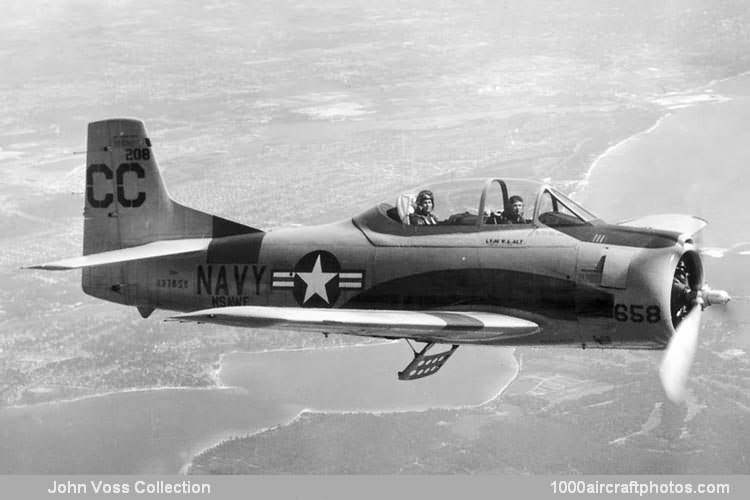01/31/2010. Remarks by Johan Visschedijk: "When the USAF initiated a design contest for a basic trainer to replace the T-6 Texan, it was to be expected that the Inglewood company would spare no effort to design a worthy successor. With the NA-159 design, the company did in fact succeed in winning the contest, and gained a contract to build two prototypes in 1948.
The designation XBT-28 had been reserved for the new basic trainer, but the 'BT' category was abandoned at about the time the NA-159 was ordered and the prototypes were built as XT-28s. The first flight was made on September 26, 1949.
Principal differences between the XT-28 and the T-6 lay in the power, an 800 hp Wright R-1300-1A engine, and in the tricycle landing gear. Like the T-6, it had a low wing, single tail unit and tandem seating for pilot and instructor. Successful flight trials led to an initial contract for 266 T-28As, the first of which was assigned as a static test specimen.
Deliveries from Inglewood began in 1950 and continued until 1953 by which time additional contracts brought total production for the USAF to 1,194. They remained in service at basic flight training schools until replaced by the jet-powered T-37A.
Following USN evaluation of two T-28As, a similar version was adopted by that service also, 489 being produced at Columbus as T-28Bs, starting in 1954. These had 1,425 hp R-1820-86 engines and minor changes, while 299 T-28Cs for the USN were distinguished by having arrester hooks to be used in dummy deck approach and landing training.
The T-28C first flew on September 19, 1955 and delivery of the last T-28C was made in 1957. One T-28B was also manufactured for Japan in 1954 when production of the type in Japan was under consideration by Mitsubishi.
When the USAF began to dispose of its T-28As, from 1958 onwards, several possible civilian uses for the type were explored. North American's Columbus division produced the NA-260 Nomad scheme, which introduced an 1,300 hp Wright R-1820-56S engine and three-blade airscrew, and after converting a prototype, licensed PacAero Engineering Corporation to undertake further similar conversions.
Hamilton Aircraft Co, Inc, of Tucson, Arizona, offered a similar engine installation in its T-28-R Nomair conversion, with the 1,200 hp Wright 704C9GC1 as an alternative. A prototype was flown in September 1960 and a production model in February 1962, to provide the basis for FAA Type Approval.
Two variants were offered, the T-28-R1 with two seats in tandem and the five-seat T-28-R2, with a fixed canopy and side door. Six T-28-R1s equipped with arrester hooks were supplied to the Brazilian Navy in 1962. A conversion of the T-28A for aerial photography duties was certificated in September 1958 by Thompson Aircraft Sales of Phoenix, Arizona.
The PacAero Nomad scheme was adopted by the French AF in 1959 for use in the desert warfare and reconnaissance role in North Africa. The original Nomad conversion was shipped to France in July 1959 and three other conversions were supplied by PacAero, plus engineering assistance to allow Sud-Aviation to convert a further 145 surplus USAF T-28As to the new standard at its Saint-Nazaire plant. In addition to the engine change, the conversion included the provision under each wing of two bomb racks and a 0.49 in (12.5 mm) gun pod. In French service the type was known as the Fennec (Dessert Fox).
In 1961, the USAF began to acquire a similar armed conversion of the T-28A, primarily for use in the MAP for other nations such as Congo, South Vietnam and South American countries. From then until early 1969, North American received 13 separate T-28 modification contracts to convert a total of 321 T-28As to T-28D configuration, and some T-28As to T-28Bs, and T-28Bs to T-28Cs.
The T-28D procured by the USAF retained the original Wright R-1300 engine but had six under-wing strong points plus two under-wing guns and, in the T-28D-5 version, a total possible under-wing load of 4,000 lb (1,814 kg). After the program at Columbus ended, further contracts were placed with Fairchild's Republic Division to convert 72 more T-28As to T-28Ds.
A program to develop a more potent counter-insurgency version of the T-28 was launched in 1962 when the USAF contracted with North American's Columbus Division for the conversion of two T-28As to YAT-28E standard (NA-284). This version had a 2,450 hp Lycoming T55 turboprop and a strengthened wing with provision for twelve hard-points in addition to two gun pods. The first aircraft (s/n 52-1242) flew on February 15, 1963, but was lost on its fourteenth flight in March.
The second aircraft was s/n 51-3786 and a third conversion was ordered to replace the first. This third aircraft (s/n 51-3788) flew in July 1964 and had additional modifications, including ejection seats for both occupants and a higher canopy. No production of the YAT-28E took place."
